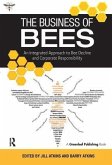Around the World in 80 Species
Exploring the Business of Extinction
Herausgeber: Atkins, Jill; Atkins, Barry
Around the World in 80 Species
Exploring the Business of Extinction
Herausgeber: Atkins, Jill; Atkins, Barry
- Gebundenes Buch
- Merkliste
- Auf die Merkliste
- Bewerten Bewerten
- Teilen
- Produkt teilen
- Produkterinnerung
- Produkterinnerung
Investigates corporate efforts to prevent extinction across 80 threatened species of flora and fauna, focusing on corporate behaviour, corporate narrative and rhetoric, and corporate accountability.
Andere Kunden interessierten sich auch für
![The Business of Bees The Business of Bees]() The Business of Bees181,99 €
The Business of Bees181,99 €![The Seven Competences of the Sustainable Professional The Seven Competences of the Sustainable Professional]() Niko RoordaThe Seven Competences of the Sustainable Professional180,99 €
Niko RoordaThe Seven Competences of the Sustainable Professional180,99 €![Activism and the Fossil Fuel Industry Activism and the Fossil Fuel Industry]() Andrew CheonActivism and the Fossil Fuel Industry181,99 €
Andrew CheonActivism and the Fossil Fuel Industry181,99 €![Trust Inc. Trust Inc.]() Matthew YeomansTrust Inc.187,99 €
Matthew YeomansTrust Inc.187,99 €![Giving Voice to Values in the Legal Profession Giving Voice to Values in the Legal Profession]() Carolyn PlumpGiving Voice to Values in the Legal Profession180,99 €
Carolyn PlumpGiving Voice to Values in the Legal Profession180,99 €![Social Entrepreneurship and Social Innovation Social Entrepreneurship and Social Innovation]() Social Entrepreneurship and Social Innovation180,99 €
Social Entrepreneurship and Social Innovation180,99 €![Digging Deeper Digging Deeper]() Dietmar SternadDigging Deeper140,99 €
Dietmar SternadDigging Deeper140,99 €-
-
-
Investigates corporate efforts to prevent extinction across 80 threatened species of flora and fauna, focusing on corporate behaviour, corporate narrative and rhetoric, and corporate accountability.
Hinweis: Dieser Artikel kann nur an eine deutsche Lieferadresse ausgeliefert werden.
Hinweis: Dieser Artikel kann nur an eine deutsche Lieferadresse ausgeliefert werden.
Produktdetails
- Produktdetails
- Verlag: Taylor & Francis Ltd (Sales)
- Seitenzahl: 434
- Erscheinungstermin: 20. November 2018
- Englisch
- Abmessung: 234mm x 156mm x 24mm
- Gewicht: 785g
- ISBN-13: 9781783538225
- ISBN-10: 1783538228
- Artikelnr.: 54710315
- Herstellerkennzeichnung
- Libri GmbH
- Europaallee 1
- 36244 Bad Hersfeld
- gpsr@libri.de
- Verlag: Taylor & Francis Ltd (Sales)
- Seitenzahl: 434
- Erscheinungstermin: 20. November 2018
- Englisch
- Abmessung: 234mm x 156mm x 24mm
- Gewicht: 785g
- ISBN-13: 9781783538225
- ISBN-10: 1783538228
- Artikelnr.: 54710315
- Herstellerkennzeichnung
- Libri GmbH
- Europaallee 1
- 36244 Bad Hersfeld
- gpsr@libri.de
Jill Atkins holds a Chair in Financial Management at Sheffield University Management School, UK, and is a visiting professor at the University of the Witwatersrand, South Africa. Barry Atkins has a background in script-writing and editing for BBC Radio and TV.
Chapter 1 Around the world in 80 species: What is mass extinction and can
we stop it?; Chapter 2 How can accounting, integrated reporting and
engagement prevent extinction?; Chapter 3 A deep ecology perspective on
extinction; Chapter 4 Species extinction and closing the loop of argument:
Imagining accounting and finance as the potential cause of human
extinction; Chapter 5 Recovered species? The eastern North Pacific grey
whale unusual mortality event, 1999-2000; Chapter 6 The Natural Capital
Protocol and the honey bee; Chapter 7 Extraction and extinction: The role
of investors in ensuring the marine health of the planet; Chapter 8 The
Convention on International Trade in Endangered Species of Wild Fauna and
Flora (CITES): An appraisal.; Chapter 9 Extinction accounting by South
African listed companies; Chapter 10 Business contributions to extinction
risk mitigation for black rhinos in Laikipia, Kenya; Chapter 11 Extinction
accounting by the public sector: South African National Parks; Chapter 12
Extinction accounting in European zoos: Reporting and practice of
conservation programmes to prevent animals from extinction; Chapter 13 An
RSPB perspective on extinction and extinction prevention: How is the RSPB
collaborating and partnering with business to prevent extinction?; Chapter
14 Endangered house sparrows and thriving red kites: Do we have useful
metrics for sustainability?; Chapter 15 Deforestation risk and the tissue
industry in Italy; Chapter 16 Accounting for captive belugas: a whale of a
business; Chapter 17 An ecological auto-ethnography of a monarch butterfly;
Chapter 18 Accounting for survival of polar bears: an arctic icon on thin
ice; Chapter 19 Panda accounting and accountability: Preventing giant panda
extinction in China; Chapter 20 Some reflections on extinction accounting,
engagement and species
we stop it?; Chapter 2 How can accounting, integrated reporting and
engagement prevent extinction?; Chapter 3 A deep ecology perspective on
extinction; Chapter 4 Species extinction and closing the loop of argument:
Imagining accounting and finance as the potential cause of human
extinction; Chapter 5 Recovered species? The eastern North Pacific grey
whale unusual mortality event, 1999-2000; Chapter 6 The Natural Capital
Protocol and the honey bee; Chapter 7 Extraction and extinction: The role
of investors in ensuring the marine health of the planet; Chapter 8 The
Convention on International Trade in Endangered Species of Wild Fauna and
Flora (CITES): An appraisal.; Chapter 9 Extinction accounting by South
African listed companies; Chapter 10 Business contributions to extinction
risk mitigation for black rhinos in Laikipia, Kenya; Chapter 11 Extinction
accounting by the public sector: South African National Parks; Chapter 12
Extinction accounting in European zoos: Reporting and practice of
conservation programmes to prevent animals from extinction; Chapter 13 An
RSPB perspective on extinction and extinction prevention: How is the RSPB
collaborating and partnering with business to prevent extinction?; Chapter
14 Endangered house sparrows and thriving red kites: Do we have useful
metrics for sustainability?; Chapter 15 Deforestation risk and the tissue
industry in Italy; Chapter 16 Accounting for captive belugas: a whale of a
business; Chapter 17 An ecological auto-ethnography of a monarch butterfly;
Chapter 18 Accounting for survival of polar bears: an arctic icon on thin
ice; Chapter 19 Panda accounting and accountability: Preventing giant panda
extinction in China; Chapter 20 Some reflections on extinction accounting,
engagement and species
Chapter 1 Around the world in 80 species: What is mass extinction and can
we stop it?; Chapter 2 How can accounting, integrated reporting and
engagement prevent extinction?; Chapter 3 A deep ecology perspective on
extinction; Chapter 4 Species extinction and closing the loop of argument:
Imagining accounting and finance as the potential cause of human
extinction; Chapter 5 Recovered species? The eastern North Pacific grey
whale unusual mortality event, 1999-2000; Chapter 6 The Natural Capital
Protocol and the honey bee; Chapter 7 Extraction and extinction: The role
of investors in ensuring the marine health of the planet; Chapter 8 The
Convention on International Trade in Endangered Species of Wild Fauna and
Flora (CITES): An appraisal.; Chapter 9 Extinction accounting by South
African listed companies; Chapter 10 Business contributions to extinction
risk mitigation for black rhinos in Laikipia, Kenya; Chapter 11 Extinction
accounting by the public sector: South African National Parks; Chapter 12
Extinction accounting in European zoos: Reporting and practice of
conservation programmes to prevent animals from extinction; Chapter 13 An
RSPB perspective on extinction and extinction prevention: How is the RSPB
collaborating and partnering with business to prevent extinction?; Chapter
14 Endangered house sparrows and thriving red kites: Do we have useful
metrics for sustainability?; Chapter 15 Deforestation risk and the tissue
industry in Italy; Chapter 16 Accounting for captive belugas: a whale of a
business; Chapter 17 An ecological auto-ethnography of a monarch butterfly;
Chapter 18 Accounting for survival of polar bears: an arctic icon on thin
ice; Chapter 19 Panda accounting and accountability: Preventing giant panda
extinction in China; Chapter 20 Some reflections on extinction accounting,
engagement and species
we stop it?; Chapter 2 How can accounting, integrated reporting and
engagement prevent extinction?; Chapter 3 A deep ecology perspective on
extinction; Chapter 4 Species extinction and closing the loop of argument:
Imagining accounting and finance as the potential cause of human
extinction; Chapter 5 Recovered species? The eastern North Pacific grey
whale unusual mortality event, 1999-2000; Chapter 6 The Natural Capital
Protocol and the honey bee; Chapter 7 Extraction and extinction: The role
of investors in ensuring the marine health of the planet; Chapter 8 The
Convention on International Trade in Endangered Species of Wild Fauna and
Flora (CITES): An appraisal.; Chapter 9 Extinction accounting by South
African listed companies; Chapter 10 Business contributions to extinction
risk mitigation for black rhinos in Laikipia, Kenya; Chapter 11 Extinction
accounting by the public sector: South African National Parks; Chapter 12
Extinction accounting in European zoos: Reporting and practice of
conservation programmes to prevent animals from extinction; Chapter 13 An
RSPB perspective on extinction and extinction prevention: How is the RSPB
collaborating and partnering with business to prevent extinction?; Chapter
14 Endangered house sparrows and thriving red kites: Do we have useful
metrics for sustainability?; Chapter 15 Deforestation risk and the tissue
industry in Italy; Chapter 16 Accounting for captive belugas: a whale of a
business; Chapter 17 An ecological auto-ethnography of a monarch butterfly;
Chapter 18 Accounting for survival of polar bears: an arctic icon on thin
ice; Chapter 19 Panda accounting and accountability: Preventing giant panda
extinction in China; Chapter 20 Some reflections on extinction accounting,
engagement and species








